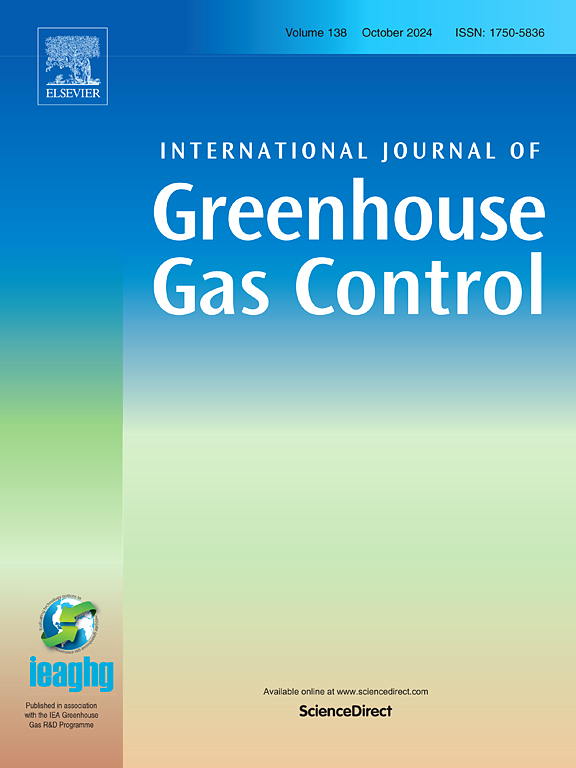Optimization of pressure management strategies for geological CO2 storage using surrogate model-based reinforcement learning
IF 4.6
3区 工程技术
Q2 ENERGY & FUELS
International Journal of Greenhouse Gas Control
Pub Date : 2024-10-01
DOI:10.1016/j.ijggc.2024.104262
引用次数: 0
Abstract
Injecting greenhouse gas (e.g. CO2) into deep underground reservoirs for permanent storage can inadvertently lead to fault reactivation, caprock fracturing and greenhouse gas leakage when the injection-induced stress exceeds the critical threshold. It is essential to monitor the evolution of pressure and the movement of the CO2 plume closely during the injection to allow for timely remediation actions or rapid adjustments to the storage design. Extraction of pre-existing fluids at various stages of the injection process, referred as pressure management, can mitigate associated risks and lessen environmental impact. However, identifying optimal pressure management strategies typically requires thousands of simulations, making the process computationally prohibitive. This paper introduces a novel surrogate model-based reinforcement learning method for devising optimal pressure management strategies for geological CO2 sequestration efficiently. Our approach comprises of two steps. The first step involves developing a surrogate model using the embed to control method, which employs an encoder-transition-decoder structure to learn dynamics in a latent or reduced space. The second step, leveraging this proxy model, utilizes reinforcement learning to find an optimal strategy that maximizes economic benefits while satisfying various control constraints. The reinforcement learning agent receives the latent state representation and immediate reward tailored for CO2 sequestration and choose real-time controls which are subject to predefined engineering constraints in order to maximize the long-term cumulative rewards. To demonstrate its effectiveness, this framework is applied to a compositional simulation model where CO2 is injected into saline aquifer. The results reveal that our surrogate model-based reinforcement learning approach significantly optimizes CO2 sequestration strategies, leading to notable economic gains compared to baseline scenarios.
利用基于代用模型的强化学习优化二氧化碳地质封存的压力管理策略
向地下深层储层注入温室气体(如二氧化碳)进行永久封存,当注入引起的应力超过临界值时,可能会无意中导致断层再活化、毛岩断裂和温室气体泄漏。在注入过程中,必须密切监测压力的变化和二氧化碳羽流的移动,以便及时采取补救措施或快速调整储层设计。在注入过程的不同阶段抽取预先存在的流体,即压力管理,可以降低相关风险,减少对环境的影响。然而,确定最佳压力管理策略通常需要进行数千次模拟,因此计算成本过高。本文介绍了一种新颖的基于代用模型的强化学习方法,用于有效设计二氧化碳地质封存的最佳压力管理策略。我们的方法包括两个步骤。第一步是利用嵌入到控制方法开发一个代理模型,该方法采用编码器-转换器-解码器结构来学习潜空间或缩小空间中的动态。第二步,利用该代理模型,通过强化学习找到一个最优策略,在满足各种控制约束条件的同时实现经济效益最大化。强化学习代理接收为二氧化碳封存量身定制的潜在状态表示和即时奖励,并根据预定义的工程约束条件选择实时控制,以实现长期累积奖励的最大化。为了证明该框架的有效性,我们将其应用于将二氧化碳注入含盐含水层的组成模拟模型。结果表明,我们基于代用模型的强化学习方法大大优化了二氧化碳封存策略,与基线方案相比取得了显著的经济效益。
本文章由计算机程序翻译,如有差异,请以英文原文为准。
求助全文
约1分钟内获得全文
求助全文
来源期刊
CiteScore
9.20
自引率
10.30%
发文量
199
审稿时长
4.8 months
期刊介绍:
The International Journal of Greenhouse Gas Control is a peer reviewed journal focusing on scientific and engineering developments in greenhouse gas control through capture and storage at large stationary emitters in the power sector and in other major resource, manufacturing and production industries. The Journal covers all greenhouse gas emissions within the power and industrial sectors, and comprises both technical and non-technical related literature in one volume. Original research, review and comments papers are included.

 求助内容:
求助内容: 应助结果提醒方式:
应助结果提醒方式:


